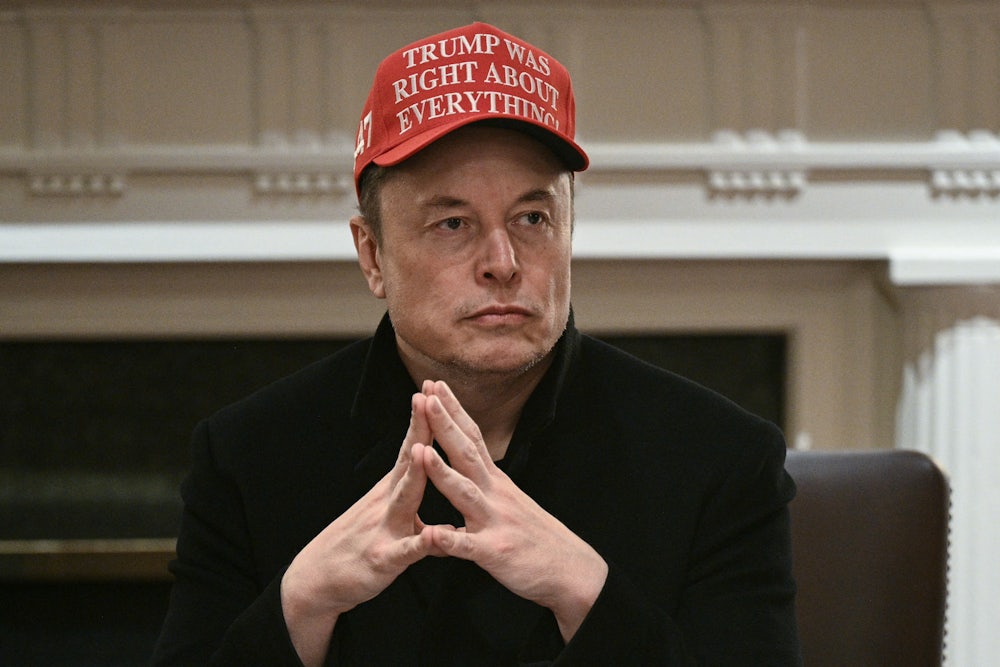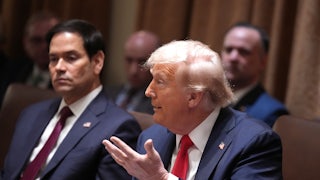“We’re going to provide affordable high-speed internet for every American—rural, urban, suburban, and tribal communities,” said Joe Biden in his State of the Union address in 2022, referring to the infrastructure law he had signed the previous November. He bragged about it again in the 2023 SOTU, and the one in 2024.
It sounded like an accomplishment that would stand as a point of pride in Biden’s legacy. But it wasn’t quite true.
In fact, while the infrastructure law created the Broadband Equity, Access, and Deployment Program, or BEAD, and seeded it with a whopping $42.5 billion to bring high-speed internet to every American household that didn’t have it, three years later it has not yet connected a single home. Now that the Trump administration has its hands on BEAD, it may take a lot of that money—as much as half of it, or even more—and give it to Elon Musk.
This is not simply a story of the red-blue divide, of Democrats trying to use government to solve a difficult problem and Republicans trying to thwart them. The truth is that while Republicans have been critical of the BEAD program’s rollout, most of them share its goal and even now would like to help push it over the finish line. Their own constituents are the ones who will benefit most, if and when BEAD delivers on its promise. But the program’s fate lies with three men: Donald Trump, Elon Musk, and Commerce Secretary Howard Lutnick. Together, the three could be about to execute a high-speed highway robbery.
Into the Bureaucratic Maze
The federal government has an almost absurd number of programs that seek to enhance internet access—133, by the count of a 2023 Government Accountability Office report, 25 of which have broadband as their primary purpose. But most of them are relatively small, doling out millions but not billions. Big Democratic spending bills, such as the Recovery Act under Barack Obama and the American Rescue Plan signed just after Joe Biden took office, included substantial broadband funding as well, but it was never enough to get high-speed internet to everyone in the country. BEAD and its multibillion-dollar budget dwarfs them all, and was to be the program that would finally achieve the goal.
Here’s how BEAD was supposed to work. First, the Federal Communications Commission, or FCC, had to complete a map that would identify every “unserved” and “underserved” area of the country, down to the level of individual homes, where there is either no or substandard broadband available. Each state then drew up an initial proposal for how it would use its portion of the BEAD funding to approach 100 percent coverage. That was then followed by an iterative process between the National Telecommunications and Information Administration, or NTIA, a part of the Department of Commerce, and state governments as the plans got more specific and refined. Eventually, the states get final approval from the NTIA and the money goes out.
It’s even more complex and cumbersome than it sounds. The legislation creating BEAD laid out a 14-step process that would have to occur before the money is dispersed, one that included numerous elements advancing liberal goals, including requiring climate resilience assessments, prevailing-wage requirements for workers, and extensive community input. These elements would become a target for Republicans, who complain that “woke” mandates have slowed the process down.
The FCC took a full year to draw up its map; only after that could the Commerce Department determine how much money each state would get. That determination was made in the spring of 2023, taking us to a year and a half after the law was passed—and a year and a half before the 2024 election. That process required an extraordinary level of detail and became frustrating for many.
One consultant working with states described to me a maddening back-and-forth as midlevel federal officials kept asking for more and more information, each time requiring days or weeks of work to produce addenda that almost no one would read and would have no effect on how the program ultimately worked. “It was process not only for the sake of process but for no reason at all. We lost six to nine months in every state,” the consultant said.
Nevertheless, the states worked hard to produce their plans, enticed by the prospect of connecting all their citizens and mounting a federally funded infrastructure effort that would produce local jobs. Yet when Biden left office, only three states—Delaware, Louisiana, and Nevada—had completed the process and gotten final approval from the Commerce Department. Thirty other states are most of the way through, with the rest still in the earlier stages.
“Every state is at the table and is interested in completing this process,” says Sarah Morris, who as deputy administrator for the NTIA was one of the key Biden administration officials overseeing BEAD. “This is a program that is on the one-yard line.”
But the one-yard line is not the end zone, which is where the Trump administration comes in. One of the central pillars of BEAD is a preference for fiber connections rather than wireless or satellite; it will fund satellite connections only in places where installing fiber is so expensive or practically difficult as to make it all but impossible.
In early March, newly minted Commerce Secretary Howard Lutnick indicated a change of direction. He attacked the “woke mandates” of the program. But he also announced that the department would be “revamping the BEAD program to take a tech-neutral approach,” which means discarding the preference for fiber. According to The Wall Street Journal, that could mean as much as $20 billion could wind up going to Starlink, Elon Musk’s satellite internet company.
Which raises an important question: For what, precisely? If you have to deliver fiber to a remote farmhouse, the thousands of dollars it could cost make sense; it’s a physical connection that has to be built out. But rural residents can already get Starlink; they’d have to pay $349 for the equipment and $120 a month for a mediocre version of the service BEAD requires, but they can get it right now (Starlink also has an $80/month option with slower speeds).
So what would the federal government buy if it gives Musk $20 billion? The answer is capacity: the bandwidth to add more customers. As it now stands, states don’t have to take the lowest bid for a connection, but Lutnick has been talking up the idea of providing service at the lowest cost, which could provide an opening to Starlink. Since it can set the amount it would bill the government at pretty much wherever it wants, Starlink can bid “$1 less than whatever they think the low bidder is,” says Blair Levin, who helped lead broadband policy in the Clinton and Obama administrations.
Not long after Lutnick shocked everyone by saying he wanted to discard the program’s preference for fiber, Evan Feinman, who ran the BEAD program under Biden, departed his position and sent a scathing letter to his colleagues. “Stranding all or part of rural America with worse internet so that we can make the world’s richest man even richer is yet another in a long line of betrayals by Washington,” he wrote.
A Three-Way Conflict
All this has set up a three-way conflict. Democrats would like the program to go forward as is. Republicans in Congress want to drop some of the “woke” requirements built into the program but still want the money to go out as soon as possible. And their own GOP allies at the state level want to make sure they don’t have to rewrite their plans, which could push progress back years, and they are also reluctant to give poorer satellite service to their constituents. A few Republicans have stressed the need to keep things on track. For instance, Senator Shelley Moore Capito of West Virginia said, “West Virginia has jumped through every hoop to deploy the $1.2 billion in broadband funding, which is sure to be a game changer for our state’s connectivity goals. While I am all for improving the program, I do not want to see West Virginia wait longer than is necessary or have to redo their proposals and application.”
Only the administration is interested in boosting satellite’s role. There isn’t much evidence that the triumvirate of Trump, Musk, and Lutnick has much of a problem with delay—or even scaling the project back. Musk’s interest is obvious, and he has already influenced Trump’s thinking. “We’re spending a trillion dollars to get cables all over the country, up to upstate areas where you have two farms,” Trump said in a misinformation-filled appearance on Joe Rogan’s podcast last October. “Elon can do it for nothing.” It isn’t hard to imagine Musk telling Trump he can do it for less, Trump seeing it as a chance to cut funding and destroy another aspect of Biden’s legacy, and Lutnick enthusiastically carrying out their wishes.
One lesson to take from the BEAD story is that, as admirable as it is, careful and cautious policy design and implementation can be dangerous. Democrats were risk-averse in many policy areas during the Biden years, working hard to cross every T and dot every I. But that takes time, and time can become the enemy of a policy’s durability.
To be fair, few could have anticipated the sheer malevolence of this administration—or the possibility that both Democrats and Republicans would agree on the necessity of a program like BEAD, have differences that are real but manageable, then watch while the needs of millions of families and communities are pushed aside so Elon Musk can get a publicly funded windfall. But that’s just what might happen.






